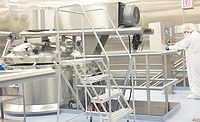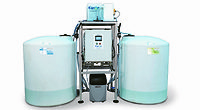Basic Elements of Effective Food Plant Cleaning and Sanitizing

It’s no secret that when the basic elements of good sanitation practices in the food manufacturing environment are consistently, even habitually, applied over time, all of the company’s food safety programs are enhanced. The cleaner the facility and equipment at the outset of every product run, the better the assurance that potential food safety hazards are mitigated or eliminated every time a shift begins and throughout the entire production cycle.
The key to good sanitation practices is to provide training to a wide base of plant employees, which may include personnel outside of the sanitation department. It is important for supporting functions to understand how they enable effective sanitation— for example, timely disassembly of equipment by maintenance staff, end of production housekeeping, and quality inspections all impact sanitation effectiveness—to foster a better understanding of—and therefore, consistent companywide adherence to—the sanitation protocols suited to each plant’s operational and food safety requirements. This cross-departmental knowledge transfer, coupled with continuous monitoring, follow up and reinforcement of best practices within the plant sanitation department, creates a corporate culture of hygiene that can significantly increase the overall effectiveness of the sanitation program. It is not enough to have an educated and dedicated sanitation crew: Their daily efforts to ensure the hygiene of the plant will be to no avail if maintenance personnel are unaware that they should not take tools from raw materials areas into finished product areas, for example, or if plant engineers do not understand the cleaning challenges posed by placement of equipment or drains.
Briefly, the five basic elements of good sanitation are:
• Assessment of environmental factors to develop effective sanitation procedures
• Commitment to continuous improvement of sanitation practices
• Proper application of daily sanitation procedures
• Use of periodic sanitation, (i.e., tear down and heat)
• Verification of effective sanitation
Here, we will review these elements, with special emphasis on the seven steps to daily sanitation procedures to illustrate the type of practical information that can be incorporated into training programs for all plant employees and managers.
Factoring In Success
There are two general environmental factors that impinge on the development of effective sanitation procedures in the food processing facility: staffing and room/equipment. Missed work due to scheduled vacations and unscheduled personal days make the necessity for a flexible workforce a must. Most processing plants have a variety of complex equipment operated by the plant’s sanitation professionals, and therefore, it is not uncommon to expect employees to rotate into different assignments as needed. This requires that sanitation supervisors vigilantly maintain good training and documentation systems that will help all sanitation crew members quickly get up and running on the procedures. This also creates an opportunity for staff in operations, quality assurance/control and engineering to regularly participate in sanitation training activities since such training might be offered more frequently given the third shift dynamic.
Second, assessment of the production area and equipment is required to hone in on the specific cleaning and sanitizing methods that will need to be applied in order to achieve effective sanitary conditions for the processing of food in a given facility. A good way to ensure that the critical elements of the sanitation process are understood is simply stated in the following
“continuum of control” formula:
Sanitary Design + Effective Sanitation + Traffic Patterns + GMPS + Dry/Uncracked Flooring
In its assessment of sanitation protocols and policies, the sanitation team will want to look at each of the control areas listed in the continuum formula:
• Sanitary design. Does existing machinery and/or new machinery require extensive disassembly? Do construction materials require different cleaning and sanitizing chemicals or methodologies based on age or frequency of use? Are components of new equipment easy to dismantle and reassemble? Are procedural controls manageable or are design changes justified?
• Effectiveness of sanitation procedures. Are limitations known and controls in place? What are the steps included in daily and periodic procedures? Are they being carried out consistently?
• Traffic patterns. Is there separation between raw and ready-to-eat areas, and separation between exposed product areas and packaging, etc.?
• GMPS. Is it difficult to do the wrong thing? For example, an operation can have the best designed equipment but if it is improperly located, the ability of personnel to comply with GMPs will suffer.
• Flooring. Is the infrastructure well maintained?
Each of these areas are necessary to the development of effective sanitation procedures, and when taken together, they provide the basis for building a comprehensive approach to ensuring high standards of hygiene and identifying potential sanitation challenges that will need to be addressed. For example, a typical challenge that might be considered as part of the sanitary design assessment is the reduced visibility in the production room due to a steam fog, which develops as a result of inadequate exhaust via the heating, ventilation and air conditioning (HVAC) system. Clearly, the sanitation staff would benefit from improved visibility in order to thoroughly clean and sanitize equipment and plant surfaces; a foggy room is not conducive to their efforts when the goal is to clean to a microbiological level. but it is difficult to see the equipment and surrounding environment.
Another typical challenge is the inaccessibility of equipment for cleaning and sanitizing. During tear down and reassembly, will the sanitation team be able to get to all the parts, or is the equipment complex and not easily cleanable to a microbiological level? Can the equipment be disassembled without tools, which enables/empowers the sanitation employee and increases effectiveness due to improved ease of the task? If the company expects the sanitation crew to control these components and maintain equipment that is free of biofilms, the equipment itself must be accessible; in other words, they need to see it and scrub it to clean it.
Among other things that can lead to ineffective sanitation—and this list is not all-inclusive—the following should be considered when developing sanitation procedures:
 • Aerosols. There is concern in the food processing industry that aerosols are a source of cross-contamination in the food plant environment. Typically, the use of high pressure/low volume water as a tool for cleaning has some level of associated risk because the velocity of the spray can generate aerosols that may migrate organisms from non-food contact surfaces to product-contact surfaces (Figure 1). High pressure water spraying also can drive moisture into and through sealed surfaces, which is not only a concern in terms of functionality but also with regard to the possible development of niches on the equipment that would provide harborage for microorganisms. If possible, high pressure water treatments should be avoided, and employed only in applications that require its use.
• Aerosols. There is concern in the food processing industry that aerosols are a source of cross-contamination in the food plant environment. Typically, the use of high pressure/low volume water as a tool for cleaning has some level of associated risk because the velocity of the spray can generate aerosols that may migrate organisms from non-food contact surfaces to product-contact surfaces (Figure 1). High pressure water spraying also can drive moisture into and through sealed surfaces, which is not only a concern in terms of functionality but also with regard to the possible development of niches on the equipment that would provide harborage for microorganisms. If possible, high pressure water treatments should be avoided, and employed only in applications that require its use.
In general, it is important to critically assess when and how to properly use high pressure/low volume water. Its use as a cleaning tool should be conducted in a controlled manner to avoid generating aerosols as much as possible. For example, it is recommended that high pressure water spray is not used as a final rinse method because the risk is greater of aerosols migrating from non-product contact surfaces to clean product contact surfaces, essentially negating sanitation efforts.
• Spraying drains and drain components. Drains are high-risk areas for harborage of undesirable microorganisms. Following Good Manufacturing Practices (GMPs) around drains and while handling drain parts helps to ensure they do not impact the surrounding environment. Personnel practices should emphasize how to prevent water from pooling or backing up. Standing water provides an environment in which bacteria can grow and survive. Better assurance is achieved when sanitation personnel who are cleaning food-contact equipment and surfaces are prohibited from also handling drain components.
• Hollow rollers, fixed sleeved assemblies and concave surfaces. It is important to identify these types of components because they will hold moisture, inhibiting the effectiveness of sanitation chemicals and cleaning methods and thus can contribute to the creation of growth environments for microorganisms or the development of biofilms.
• Control buttons, screens and bearings. These are all types of equipment components that often require special cleaning protocols but the details of those cleaning processes are often easily missed because these components are often covered during the cleaning process. It is important to specifically identify a cleaning methodology for these items—before and after covering—to prevent the possibility that they become transfer vehicles for bacteria.
In general, the sanitation process should be documented and sequenced such that protocols can be sustained. This means determining the necessary tasks, when and at what frequency those tasks should happen and in what specific order they should occur in order to ensure that sanitation methods are applied consistently. Again, training is key and should be conducted consistently to prevent erosion of institutional knowledge and thus enhance the proper application of sanitation protocols.
The main objective is to reach and maintain a state of continuous improvement of sanitation practices. In the short term, the sanitation department handles challenges through the implementation of protocols and controls. As an example, sanitation practices involving the element of sanitary equipment design will dictate that equipment is taken apart to the necessary level to ensure that a clean, sanitary state is maintained. Achieving long-term continuous improvement involves improving upon that particular design to make it easy for people to do the right thing. In other words, if a task is difficult to do, the likelihood that it will be done consistently is significantly reduced. The ultimate goal in terms of long-term continuous improvement in this example is to simplify equipment designs so that they have fewer components, have an open design and are easily accessible for cleaning to a microbiological level. Continuous improvement is very important to assuring the effective transfer of knowledge, effective training and ultimately, effective sanitation.
Looking for a reprint of this article?
From high-res PDFs to custom plaques, order your copy today!







